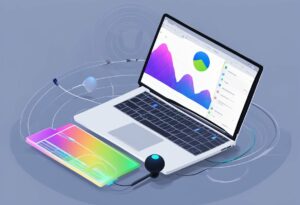Desktop video conferencing has revolutionized the way people communicate and collaborate across distances. Using this technology, individuals can participate in real-time meetings via their computers or smart devices, irrespective of their physical location. This has become essential for businesses, allowing team members working remotely to connect as if they were in the same room, enhancing productivity and reducing the need for travel.

The technology underpinning video conferencing is complex but designed to be user-friendly for participants. It blends audiovisual data transmission, often with the assistance of AI, to deliver a seamless communication experience. Integrating such tools into daily operations has supported a range of applications, from conducting job interviews and sales presentations to routine team catch-ups and strategic planning sessions.
Key Takeaways
- Desktop video conferencing facilitates real-time interaction.
- Essential for remote collaboration and communication.
- Enhances productivity with a user-friendly interface.
History and Evolution of Desktop Video Conferencing

Over the years, I’ve watched desktop video conferencing grow from a rudimentary communication tool to a sophisticated and essential technology in the modern world.
Early Beginnings
My understanding of the early days starts in 1968 when video conferencing was introduced at the World’s Fair in New York with the Picturephone from AT&T. However, the real turning point for desktop video conferencing was the 1980s computer revolution. By 1991, IBM and PictureTel had launched the first PC-based video conferencing solution. It included a video camera, microphone, speakers, and software, making it possible to hold video calls on a personal computer.
Modern Advances
The advent of the Internet transformed desktop video conferencing, bringing about HD video and improving the overall quality significantly. With the internet, I’ve seen encryption become a pivotal part of the technology, ensuring secure communications. During the 2020s, circumstances like the COVID-19 pandemic necessitated remote interactions, causing a surge in desktop video conferencing usage. Video conferencing software evolved rapidly, prioritizing user-friendly interfaces and reliable connections. The last decade saw desktop video conferencing become an integral part of daily life, revolutionizing how I work, learn, and communicate.
Technical Aspects of Video Conferencing
In this section, I’ll explore the essential technologies that enable desktop video conferencing. These include the intricacies of audio and video technology, the variety of software and applications available, the core hardware requirements, and the necessary connectivity and bandwidth considerations.

Audio and Video Technology
Audio clarity and video quality are central to a productive video conferencing experience. High-definition (HD) audio and video transmission are achieved through advanced codecs that compress and decompress data. Key features include echo cancellation, noise suppression, and automatic gain control, which ensure clear audio. On the video front, modern conferencing depends on high-resolution cameras and displays.
Software and Applications
Video conferencing software such as Zoom, Microsoft Teams, Slack, and GoToMeeting act as the platform for these meetings. These applications provide a user interface with controls for managing the meeting, such as mute/unmute, screen sharing, and participant management. They often come with collaboration tools like whiteboarding and file sharing, and include encryption for security.
Hardware Requirements
For a setup capable of video conferencing, the following hardware is essential:
- Video camera: Often HD, capturing clear visuals.
- Microphone: For crisp audio pickup.
- Speakers: To hear participants with clarity.
My device, whether it’s a desktop computer or a dedicated system, must support these peripherals.
Connectivity and Bandwidth
A stable internet connection is pivotal to video conferencing. Bandwidth influences the quality of audio and video; higher bandwidth supports higher resolutions and frame rates. I should ensure that my network can handle the transmission of HD content to avoid interruptions or degraded conferencing quality.
Use Cases and Applications

In the realm of desktop video conferencing, its practicality sweeps across numerous aspects of professional environments. I focus on how its versatile nature facilitates various corporate activities.
Corporate and Business Meetings
Business and Team Coordination: I often see desktop video conferencing as a cornerstone in today’s businesses, especially for team coordination. Team members participate in virtual meetings from various locations, leveraging real-time communication to discuss projects, share updates, and make collaborative decisions—all without the need for physical presence. This fosters an environment conducive to remote work, allowing for a seamless transition between in-office and off-site operations.
- Meeting with Clients: I’ve noted that maintaining strong client relations is crucial for any business. Through desktop video conferencing, businesses can conduct face-to-face meetings with clients irrespective of geographic boundaries. Such interactions are invaluable, as they allow for personal engagement, presentation of ideas, and immediate feedback. Furthermore, the ability to share screens, documents, and other multimedia aids enhances the effectiveness of these meetings.
Given the current global business landscape, the use cases of desktop video conferencing continue to grow and adapt, underscoring its indispensability for modern enterprises.
Frequently Asked Questions

In this section, I answer commonly asked questions about desktop video conferencing to help you understand its role and features in a business environment.
How is desktop video conferencing utilized in business settings?
Desktop video conferencing is used in businesses to facilitate meetings, interviews, and collaborative projects among teams that are geographically dispersed. It allows participants to have face-to-face communication virtually, which can improve productivity and decision-making processes.
What are the core functionalities of desktop video conferencing software?
The core functionalities include high-definition video and audio transmission, screen sharing, and chat functionalities. More advanced software may also offer features like recording, whiteboarding, and user management tools to enhance the effectiveness of virtual meetings.
How does desktop video conferencing enhance remote collaboration?
Desktop video conferencing enables real-time collaboration, mimicking an in-person meeting experience. It allows for instant sharing of documents and visual aids while providing visual cues and body language that are key to effective communication and team cohesion.
What separates desktop video conferencing from other forms of video communication?
Desktop video conferencing is specifically designed for professional settings, offering tools that facilitate group meetings, like scheduling, agenda setting, and roles assignment. It is distinguished by its business-oriented features that help in managing and conducting structured meetings.
Can desktop video conferencing systems integrate with other business tools?
Yes, many desktop video conferencing systems can integrate with business tools like calendar systems, email platforms, and project management apps to streamline workflows and improve efficiency in organizing and conducting meetings.
What security features are important in desktop video conferencing platforms?
Security features such as end-to-end encryption, strong user authentication protocols, and the ability to control meeting access are crucial in protecting sensitive business information and ensuring privacy during video conferencing sessions.




